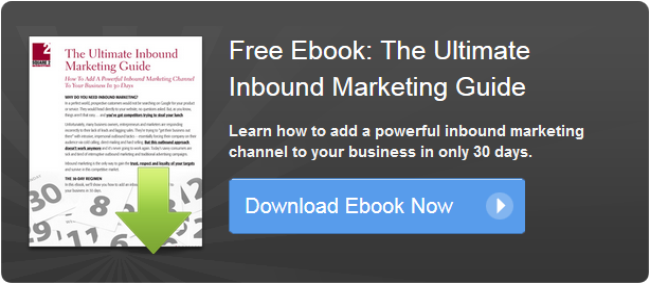Transitioning to Inbound: A Recipe for Long-Term Success
Transitioning to Inbound: A Recipe for Long-Term Success:
from HubSpot's Inbound Internet Marketing Blog
 Change is hard. Most people will naturally resist it. But for organizations to keep pace in a rapidly changing business world, they need to embrace change -- and leaders need to make it comfortable for employees to embrace it, too.
Change is hard. Most people will naturally resist it. But for organizations to keep pace in a rapidly changing business world, they need to embrace change -- and leaders need to make it comfortable for employees to embrace it, too.
Anyone who has ever adopted an inbound marketing program knows supporting this environment of change is critical to success. In my experience, the best way to do that is to set expectations early about what the transition will look like in the first four to six weeks so that initial kickoff goes off without a hitch.
That initial phase is about planning, thinking, and starting the work required to get all the foundational elements in place so the program helps your business get found, get leads, and grow sales. Without this work, you run the risk of implementing marketing tactics that don’t speak directly to your target prospect, are disconnected from each other, and are ineffective at generating leads.
To help you or your clients started with an inbound marketing program the right way, here's everything you should slot out to do during the first six weeks of implementation. I'll leave it up to you to establish specific timelines that align with the resources you have on hand, but this "to-do" list should help you plan a successful launch -- and perhaps make your organization a little more amenable to change, too.
First, Set Your Strategy (Not Your Tactics)
Not yet, anyway. The first phase of a well thought out inbound marketing program, the marketing strategy, is a little like building the foundation of your house. Without a strong foundation, your house could collapse. For instance, what are your business goals? Do you want to go from a $10 million business to a $20 million business in 2 years, or do you want to go from a $10 million business to a $10.5 million business in 3 years? Different goals often translate into a different inbound marketing program.Before you get into tactics, asking yourself these questions will help make some difficult decisions you'll have to make in the first six weeks much easier.
Questions to Ask About Baseline Metrics:
You'll need to establish a baseline for the business today. How many people visit your website each month? How many convert into leads? How many of those are actual sales opportunities? How many of those do you close? What is the average revenue for each of those new clients? How many clients do you lose each month? How many email addresses do you have? How many Facebook fans, LinkedIn connections or Twitter followers have you accumulated?Questions to Ask About Target Market:
Who do you want to target with your marketing? What does your best customer look like? Why do people choose you over your competition? What makes you special, remarkable, different?Questions to Ask About Search:
What keywords are people using to find businesses like yours? Do you want to be found for those keywords? What other keywords should you be optimizing for?Questions to Ask About Content Assets:
What content assets do you already have, digital or otherwise? (Go through every brochure, article, press release, newspaper article, video, mailer, technical manual, or Christmas card and see what can be repurposed. Not everything has to be created from scratch.)Questions to Ask About Content Creation:
What is your editorial calendar going to look like? The more you think through and plan out your inbound marketing program, the easier it is to implement. Plan out your next three months of blog posts, emails, webinars, and content projects to turbo-charge your results and ease the burden of coming up with new ideas for this stuff every single day.Questions to Ask About Campaigns:
What campaign schedule do you want to roll out? How often are you going to email, blog, create new content, or run a webinar? Are you going to run any integrated campaigns? What are they going to focus on, and who are they going to target? When do you want to launch your campaigns and how long are they going to run?Questions to Ask About Budget:
What budget do you have for inbound marketing, along with other out of pocket expenses like PPC, press releases, video production, or mobile apps?Thinking through the answers to these questions lets you create an inbound marketing program that's perfectly aligned with your business goals, current marketing situation, and future business direction.
You'll also have to do some goal setting to measure your performance. This includes establishing goals for website traffic, lead generation, conversion rates, and close rates. This will help you select the right set of marketing tactics delivered at the right frequency to deliver on those goals -- and ultimately help you tie your inbound marketing activities into revenue.
For example, let's say you need to improve website traffic by a factor of 10. In that case, you're going to need a heavy dose of blogging, onsite SEO, offsite SEO, content creation, content sourcing, and social media marketing. But if your business already has a lot of traffic but no leads, your program needs to include a website design upgrade, more graphic call-to-action buttons, landing pages, and additional offers like webinars, demos, and videos. The tactics have to match the marketing strategy if you want to realize results.
Get Some Quick Wins
Everyone wants results fast. And that’s fine -- as long as you recognize moving to tactics before the strategy and planning is completed comes along with its share of risks. You might be sending the wrong messages to the right people. You might be sending the right messages to the wrong people. You might be sending the right messages to the right people but in the wrong format, like sending a video to people who want to read. While quick wins help get your new program some up-front buy-in, keep in mind this should be a short term option and not an option to replace the development of a solid marketing strategy and plan.Here are a few options for jump starting your program during the first four to six weeks, and helping make the transition more comfortable for those watching the bottom line:
1) Repurpose a piece of existing content that you have to create a downloadable item. This could be an explanation of a unique process your business uses, a checklist you go through with each client or customer, or an existing whitepaper you can reformat use as lead generation content. Just make sure the content is something your prospects will find valuable at some point in the buying cycle -- not just a brochure about you and your business.
2) Create a call-to-action graphic or button that draws current site visitors to your newly created educational material.
3) Create your first landing page. If you do not have the technical abilities for this in-house, remember to factor in a little more time to outsource this landing page creation.
4) Send an email to your existing contact database that brings them to this landing page and encourages them to download the educational piece you’ve created -- be sure to select the people that align with the stage in the buying cycle that piece of content most relates to.
5) Integrate this into your sales process by encouraging your sales people to promote this new educational material with their prospects. Use this to collect new email addresses and move the sales process along.
This jump start approach gives you a taste of what the inbound marketing experience will be like once your program is up and running. These five items above are a small subset of what will be getting done weekly and monthly when your program is in full swing, but it's a way to get some quick wins under your belt that'll help you garner more internal buy-in for future changes you'll want to make.
The first six weeks of an inbound marketing engagement typically requires patience. Inbound marketing is not a silver bullet to success, nor is it the famed and oft-sought “easy button.” It requires work, continuous improvement, and planning. It won't change the face of your business in a day, but if done properly will provide your business with a scalable marketing system that, over time, helps your business get found, get leads, grow sales, and reach your business goals more efficiently.
This is a guest post written by Mike Lieberman, president of Square 2 Marketing, a Platinum-level HubSpot agency partner. He is also the co-author of the new book, Fire Your Sales Team Today!




No comments:
Post a Comment